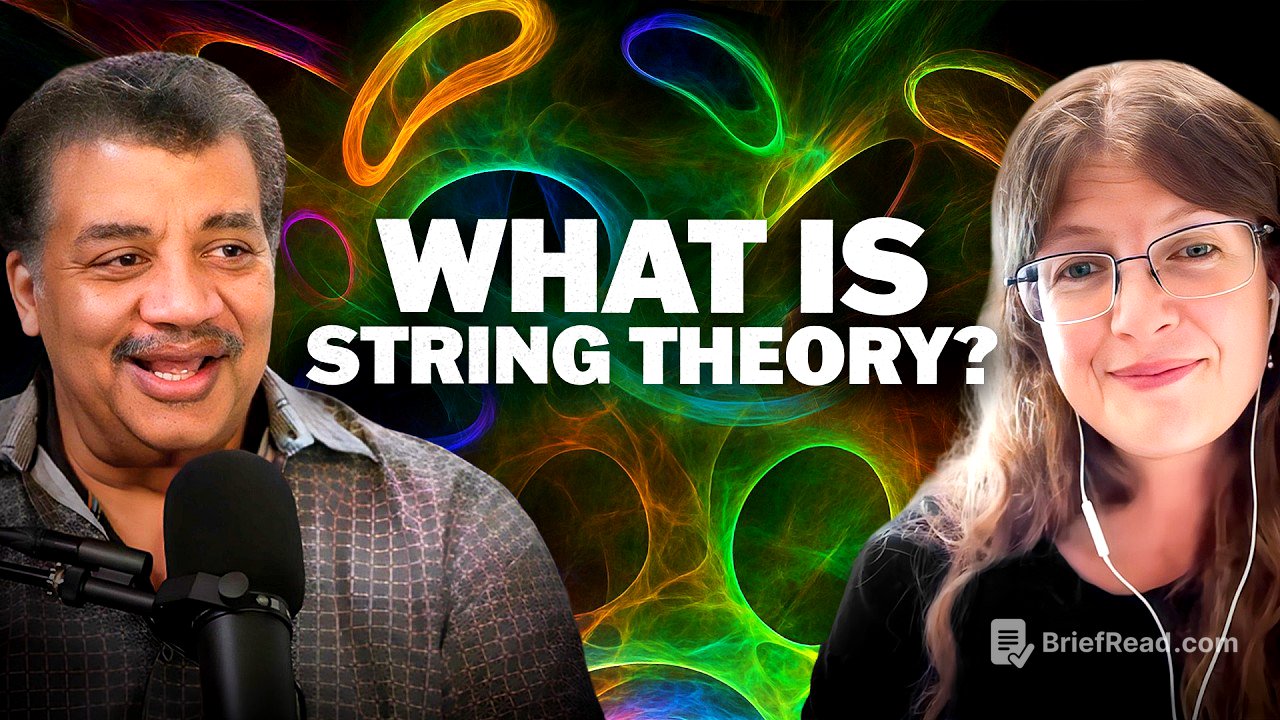TLDR;
This StarTalk episode features Neil deGrasse Tyson, Chuck Nice, and theoretical physicist Laura Anderson discussing string theory. The conversation covers the basics of string theory as an attempt to reconcile general relativity with quantum mechanics, the necessity of extra dimensions, the challenges of testing the theory, and the concept of the string landscape. They also touch on the holographic principle, the use of AI in solving complex equations, and the potential for string theory to reveal new physics. The episode concludes with a discussion on symmetry, mirror symmetry, and the interplay between physics and mathematics.
- String theory attempts to reconcile general relativity and quantum mechanics.
- Extra dimensions are necessary for string theory to work, but they must be compact.
- Testing string theory is challenging due to the high energy scales required.
- The holographic principle suggests a deep relationship between gravity and gauge theories.
- AI is being used to solve complex equations in string theory.
Introduction: Lara Anderson [0:00]
Neil deGrasse Tyson introduces the topic of string theory and welcomes Laura Anderson, an associate professor of physics at Virginia Tech, to StarTalk. Anderson also has an affiliation with the mathematics department. Tyson notes the difficulty of understanding string theory and sets the stage for a discussion about its fundamental concepts and implications.
What is String Theory? [3:14]
Laura Anderson defines string theory as an attempt to reconcile Einstein's theory of general relativity with quantum mechanics and quantum field theory, aiming to create a consistent quantum theory of gravity. She explains that while it may not perfectly describe our universe, it serves as a valuable theoretical framework for exploring quantum gravity. The core issue is the incompatibility of general relativity, which describes gravity as the curvature of spacetime, with quantum field theory, which accurately describes the fundamental forces and particles but leads to "disastrous infinities" when combined with gravity at very small scales or in extreme gravitational conditions like those found in black holes.
Can We Keep Getting Smaller? [6:50]
The discussion shifts to the fundamental nature of particles. While particles like electrons and quarks are currently considered fundamental, string theory suggests they are not the smallest constituents of the universe. Instead, string theory posits that these particles are different vibrational modes of tiny, one-dimensional strings. These strings are so small that directly observing them would require a particle accelerator the size of the solar system, which is not currently feasible.
Extra Dimensions Necessary [11:01]
Anderson explains that string theory requires more than the three spatial and one time dimension that we observe. For the equations of string theory to work, additional spatial dimensions are needed. These extra dimensions must be "compact," meaning they are curled up and very small compared to the dimensions we experience. The idea of compactified time dimensions is also raised, but Anderson notes that maintaining causality in such theories is challenging.
Can You Test String Theory? [17:00]
The conversation addresses the criticism that string theory is not testable. Anderson acknowledges the difficulty of direct experimental verification due to the extremely high energy scales required. However, she argues that string theory makes interconnected predictions about various aspects of physics, such as particle physics and cosmology. Testing these interconnected predictions could provide indirect evidence for or against string theory. If a solution of string theory could accurately predict the masses and properties of known particles, it would be a significant step forward.
The String Landscape [23:50]
One of the challenges in string theory is the vast number of possible configurations for the extra dimensions, often referred to as the "string landscape." Initially, it was hoped that there would be only a few possible configurations, but it turns out there may be half a billion or more. This leads to the criticism that string theory is not predictive because it allows for too many possibilities. Anderson counters that even with this vast landscape, string theory can still be useful if it can correlate features in cosmology and particle physics.
Quantum Phenomenology [27:53]
Anderson defines particle phenomenology within string theory as the effort to find solutions that resemble the particle physics we observe, such as the Standard Model. She explains that her research focuses on identifying the properties of extra dimensions that would lead to particle physics close to what we see in our universe. Despite the large number of possible solutions, many do not include even basic elements like electrons, highlighting the need to narrow down the possibilities.
Discovering the Holographic Principle [29:40]
Anderson discusses the holographic principle as one of the significant discoveries arising from string theory. This principle suggests a deep relationship between gravity and gauge theories, indicating that gravitational theories can be related to gauge theories living on the boundary of that space. The holographic principle implies that particle physics and gravity are not as different as previously thought.
Knots in Four Dimensions [34:00]
Tyson brings up the concept of knots and how they behave differently in different dimensions. In three dimensions, knots can be tied and untied, but in four dimensions, they can be easily unraveled. In two dimensions, knots cannot be untied without lifting the string out of the plane. This leads to a discussion of how the properties of space and time change with different dimensions and how this affects the way physicists think about gravity and the structure of the universe.
Using AI for String Theory [41:16]
The conversation turns to the use of artificial intelligence in solving complex equations in string theory. Anderson explains that she and her collaborators have been using machine learning algorithms to numerically solve differential equations that are otherwise intractable. This has led to significant speedups in computations and has made it possible to compute quark masses in string theory for the first time.
Can String Theory Bring New Physics? [42:57]
Tyson asks whether string theory could lead to the discovery of new physics beyond the Standard Model and general relativity. Anderson suggests that new physics could take the form of additional fundamental forces, explanations for dark energy and dark matter, or a resolution to the singularities predicted by general relativity in black holes. While remaining agnostic about string theory's ultimate success, she emphasizes the importance of pushing the theory to its limits to see if it can make testable predictions or reveal its limitations.
Less Supersymmetry & Celebrating Symmetry [46:17]
Anderson introduces the concept of duality in string theory, where two different theories or geometries are secretly different sides of the same coin. She and her collaborators are working on new examples of dualities that require less supersymmetry. Supersymmetry is a theoretical concept that posits that all known particles have heavier partners. While supersymmetry has not been observed at the Large Hadron Collider (LHC), it still plays a role in some formulations of string theory by regulating the quantum mechanical behavior of the theory. Anderson celebrates the idea of symmetry in physics, explaining that it is a powerful tool for understanding the fundamental laws of nature. Symmetries are rules for how to change a space or an equation in ways that leave it unchanged, and they can reveal deep connections between seemingly disparate phenomena.
Mirror Symmetry & Calabia Manifolds [54:38]
Anderson explains mirror symmetry, a concept discovered in the context of string compactifications. It suggests that all solutions come in pairs and these pairs involve interchanging topological numbers. She also discusses Calabi-Yau manifolds, which are examples of configurations for the shapes of extra dimensions in string theory that satisfy Einstein's equations. These manifolds were conjectured to exist by Eugene Calabi and proven by Shing-Tung Yau.
A Cosmic Perspective [1:00:10]
Neil deGrasse Tyson offers a cosmic perspective, emphasizing the importance of allowing researchers to explore the boundaries of knowledge without the pressure of immediate practical applications. He highlights the historical connection between advances in physics and mathematics, noting that these fields are fundamental to our understanding of the universe. He concludes by expressing hope for further advances in both physics and mathematics, regardless of how obscure they may seem today.









